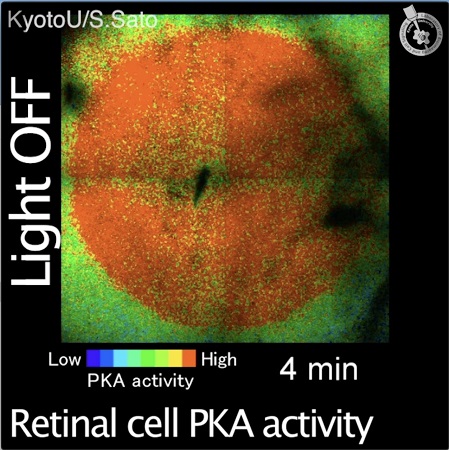Glowing mice shine light on night vision
Kyoto, Japan -- Publishing in PNAS , biologists at Kyoto University report on a previously unknown mechanism in the retina that will perhaps lead to a better understanding of how our eyes see at night. The finding was made possible thanks to mice engineered to change fluorescence when a specific molecule — protein kinase A, or PKA — is activated.
These 'PKAchu' mice were developed to provide researchers with a way of visualizing the activation of one of the body's most essential and widely studied proteins.
"PKA is found in many cells and is involved in a wide variety of biological processes. It's natural that researchers would find a way to observe its activities," explains first author Shinya Sato of the Graduate School of Biostudies.
"PKAchu mice were developed in 2012 — 'chu' being Japanese for 'squeak'— to allow us to closely monitor how PKA acts during specific biological processes. I decided to apply this to my work in retina biology."
The team first developed a method for recording high resolution, microscopic images of living retinal tissue. They then observed how PKA reacts to light stimulation. Knowing the pathways involved, the team hypothesized that light would deactivate PKA.
But to their surprise, the exact opposite happened.
"We started with a six-second illumination of the tissue. Incredibly, this activated PKA in the selected area for nearly 15 minutes," continues Sato. "We then did a ten-minute illumination, during which PKA was inactive. But when the lights were turned off, PKA kicked into gear. It was as if the darkness had activated it."
Single-cell level analysis revealed that this lights-off PKA activation occurred only in rod cells, which are indispensable for our night vision.
Sato hypothesizes that this previously unknown mechanism of rod-specific PKA activation may be a key in boosting light sensitivity in our eyes, contributing to our night vision. Rod-type photoreceptor cells are thought to have evolved from color-sensing cone cells. PKA activation, it now appears, is rod-specific.
Michiyuki Matsuda, the study's senior author, concludes: "We have not only uncovered many interesting aspects of retinal cells, but the further utility of PKAchu mice as well. We are excited to uncover the mechanisms and purpose behind these new findings, and perhaps illuminate our understanding of conditions such as night blindness."

Retinal cells from PKAchu. PKA is activated by darkness only in the stimulated area (Kyoto University/Matsuda Lab)
Related Link
- Detect with PKAchu
https://youtu.be/iqci24vXY_o
Paper Information
【DOI】 https://doi.org/10.1073/pnas.2009164117
Shinya Sato, Takahiro Yamashita, and Michiyuki Matsuda (2020). Rhodopsin-mediated light-off-induced protein kinase A activation in mouse rod photoreceptor cells. Proceedings of the National Academy of Sciences of the United States of America, 117(43), 26996-27003.





